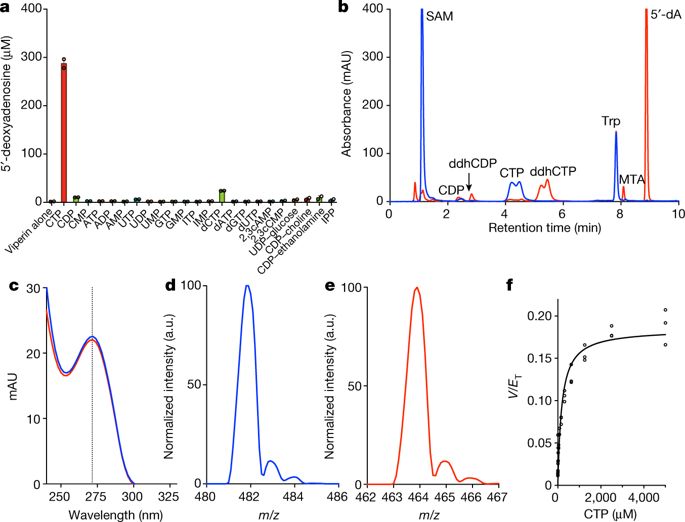Our official English website, www.x-mol.net, welcomes your
feedback! (Note: you will need to create a separate account there.)
A naturally occurring antiviral ribonucleotide encoded by the human genome
Nature ( IF 50.5 ) Pub Date : 2018-06-01 , DOI: 10.1038/s41586-018-0238-4 Anthony S Gizzi 1 , Tyler L Grove 1 , Jamie J Arnold 2 , Joyce Jose 2 , Rohit K Jangra 3 , Scott J Garforth 1 , Quan Du 1 , Sean M Cahill 1 , Natalya G Dulyaninova 1 , James D Love 4 , Kartik Chandran 3 , Anne R Bresnick 1 , Craig E Cameron 2 , Steven C Almo 1, 4
Nature ( IF 50.5 ) Pub Date : 2018-06-01 , DOI: 10.1038/s41586-018-0238-4 Anthony S Gizzi 1 , Tyler L Grove 1 , Jamie J Arnold 2 , Joyce Jose 2 , Rohit K Jangra 3 , Scott J Garforth 1 , Quan Du 1 , Sean M Cahill 1 , Natalya G Dulyaninova 1 , James D Love 4 , Kartik Chandran 3 , Anne R Bresnick 1 , Craig E Cameron 2 , Steven C Almo 1, 4
Affiliation

|
Viral infections continue to represent major challenges to public health, and an enhanced mechanistic understanding of the processes that contribute to viral life cycles is necessary for the development of new therapeutic strategies1. Viperin, a member of the radical S-adenosyl-l-methionine (SAM) superfamily of enzymes, is an interferon-inducible protein implicated in the inhibition of replication of a broad range of RNA and DNA viruses, including dengue virus, West Nile virus, hepatitis C virus, influenza A virus, rabies virus2 and HIV3,4. Viperin has been suggested to elicit these broad antiviral activities through interactions with a large number of functionally unrelated host and viral proteins3,4. Here we demonstrate that viperin catalyses the conversion of cytidine triphosphate (CTP) to 3ʹ-deoxy-3′,4ʹ-didehydro-CTP (ddhCTP), a previously undescribed biologically relevant molecule, via a SAM-dependent radical mechanism. We show that mammalian cells expressing viperin and macrophages stimulated with IFNα produce substantial quantities of ddhCTP. We also establish that ddhCTP acts as a chain terminator for the RNA-dependent RNA polymerases from multiple members of the Flavivirus genus, and show that ddhCTP directly inhibits replication of Zika virus in vivo. These findings suggest a partially unifying mechanism for the broad antiviral effects of viperin that is based on the intrinsic enzymatic properties of the protein and involves the generation of a naturally occurring replication-chain terminator encoded by mammalian genomes.Viperin inhibits the replication of various viruses by catalysing the conversion of CTP to ddhCTP, which is a unique nucleotide that functions as replication-chain terminator of RNA-dependent RNA polymerases.
中文翻译:

由人类基因组编码的天然抗病毒核糖核苷酸
病毒感染继续代表着公共卫生面临的重大挑战,并且对促进病毒生命周期过程的机制的深入理解对于开发新的治疗策略 1 是必要的。Viperin 是 S-腺苷-l-甲硫氨酸 (SAM) 酶超家族的成员,是一种干扰素诱导蛋白,参与抑制多种 RNA 和 DNA 病毒的复制,包括登革热病毒、西尼罗河病毒、丙型肝炎病毒、甲型流感病毒、狂犬病病毒2和HIV3、4。Viperin 已被建议通过与大量功能无关的宿主和病毒蛋白相互作用来引发这些广泛的抗病毒活性 3,4。在这里,我们证明了毒蛇素催化三磷酸胞苷 (CTP) 转化为 3ʹ-deoxy-3',4ʹ-didehydro-CTP (ddhCTP),以前未描述的生物相关分子,通过 SAM 依赖的自由基机制。我们表明表达 viperin 的哺乳动物细胞和用 IFNα 刺激的巨噬细胞产生大量的 ddhCTP。我们还确定 ddhCTP 作为来自黄病毒属多个成员的 RNA 依赖性 RNA 聚合酶的链终止子,并表明 ddhCTP 在体内直接抑制寨卡病毒的复制。这些发现表明了 viperin 广泛抗病毒作用的部分统一机制,该机制基于蛋白质的内在酶特性,并涉及产生由哺乳动物基因组编码的天然复制链终止子。 Viperin 通过以下方式抑制各种病毒的复制催化 CTP 转化为 ddhCTP,
更新日期:2018-06-01
中文翻译:

由人类基因组编码的天然抗病毒核糖核苷酸
病毒感染继续代表着公共卫生面临的重大挑战,并且对促进病毒生命周期过程的机制的深入理解对于开发新的治疗策略 1 是必要的。Viperin 是 S-腺苷-l-甲硫氨酸 (SAM) 酶超家族的成员,是一种干扰素诱导蛋白,参与抑制多种 RNA 和 DNA 病毒的复制,包括登革热病毒、西尼罗河病毒、丙型肝炎病毒、甲型流感病毒、狂犬病病毒2和HIV3、4。Viperin 已被建议通过与大量功能无关的宿主和病毒蛋白相互作用来引发这些广泛的抗病毒活性 3,4。在这里,我们证明了毒蛇素催化三磷酸胞苷 (CTP) 转化为 3ʹ-deoxy-3',4ʹ-didehydro-CTP (ddhCTP),以前未描述的生物相关分子,通过 SAM 依赖的自由基机制。我们表明表达 viperin 的哺乳动物细胞和用 IFNα 刺激的巨噬细胞产生大量的 ddhCTP。我们还确定 ddhCTP 作为来自黄病毒属多个成员的 RNA 依赖性 RNA 聚合酶的链终止子,并表明 ddhCTP 在体内直接抑制寨卡病毒的复制。这些发现表明了 viperin 广泛抗病毒作用的部分统一机制,该机制基于蛋白质的内在酶特性,并涉及产生由哺乳动物基因组编码的天然复制链终止子。 Viperin 通过以下方式抑制各种病毒的复制催化 CTP 转化为 ddhCTP,











































 京公网安备 11010802027423号
京公网安备 11010802027423号